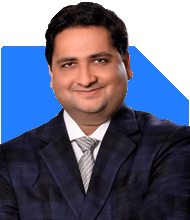Confused 8% Return Investor vs. 30% CAGR Equity Investor, Seeking Clarity
Ramalingam Kalirajan |9854 Answers |Ask -Follow
Mutual Funds, Financial Planning Expert - Answered on Nov 07, 2024
He has an MBA in finance from the University of Madras and is a certified financial planner.
He is the director and chief financial planner at Holistic Investment, a Chennai-based firm that offers financial planning and wealth management advice.... more

Thanks for your response. However, the answer to my very specific question is long, vague and hard to understand with sprinkling of advice on switching to MFs etc. I am an very avid investor in the equity stock market with 30% cagr returns for past 3 years (However, for thr sake of being conservative, I have quited 8% pa returns). I am quite disappointed with the above vague and generic answer to my question, will try to work on my own to get the answers now. Thanks for your time and efforts.
Best Regards,
K. Ramalingam, MBA, CFP,
Chief Financial Planner,
www.holisticinvestment.in
https://www.youtube.com/@HolisticInvestment
You may like to see similar questions and answers below
Hardik Parikh | Answer |Ask -Follow
Tax, Mutual Fund Expert - Answered on Apr 07, 2023
Vivek Lala | Answer |Ask -Follow
Tax, MF Expert - Answered on Oct 09, 2023
Ramalingam Kalirajan |9854 Answers |Ask -Follow
Mutual Funds, Financial Planning Expert - Answered on Jun 26, 2024
Ramalingam Kalirajan |9854 Answers |Ask -Follow
Mutual Funds, Financial Planning Expert - Answered on Oct 14, 2024
Ramalingam Kalirajan |9854 Answers |Ask -Follow
Mutual Funds, Financial Planning Expert - Answered on Oct 30, 2024
Nayagam P P |9466 Answers |Ask -Follow
Career Counsellor - Answered on Jul 27, 2025
Nayagam P P |9466 Answers |Ask -Follow
Career Counsellor - Answered on Jul 27, 2025
Nayagam P P |9466 Answers |Ask -Follow
Career Counsellor - Answered on Jul 27, 2025
Nayagam P P |9466 Answers |Ask -Follow
Career Counsellor - Answered on Jul 27, 2025
Nayagam P P |9466 Answers |Ask -Follow
Career Counsellor - Answered on Jul 27, 2025
Nayagam P P |9466 Answers |Ask -Follow
Career Counsellor - Answered on Jul 27, 2025
Nayagam P P |9466 Answers |Ask -Follow
Career Counsellor - Answered on Jul 27, 2025
Nayagam P P |9466 Answers |Ask -Follow
Career Counsellor - Answered on Jul 27, 2025
Nayagam P P |9466 Answers |Ask -Follow
Career Counsellor - Answered on Jul 27, 2025
Nayagam P P |9466 Answers |Ask -Follow
Career Counsellor - Answered on Jul 27, 2025




















